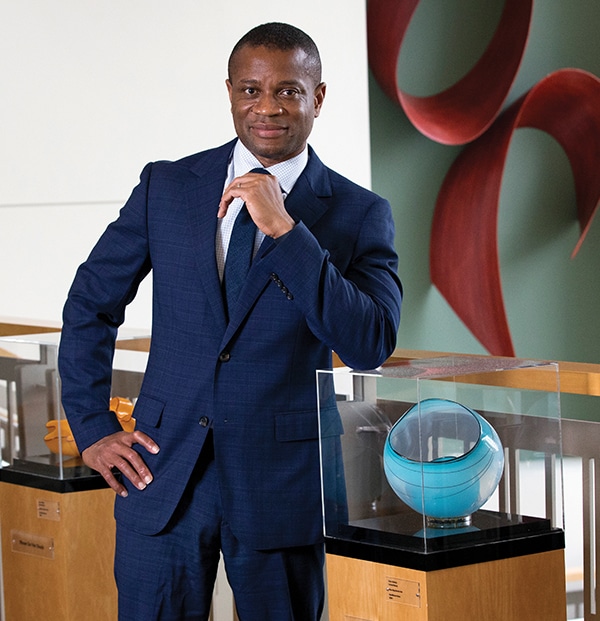Karen Titus
November 2022—The lack of tools for assessing traumatic brain injury has long bedeviled physicians. There’s CT. And then?
“This has been an unmet medical need for years,” says Ramon Diaz-Arrastia, MD, PhD, the John McCrea Dickson, MD, professor of neurology and director of the Clinical Traumatic Brain Injury Research Center, University of Pennsylvania Perelman School of Medicine. “As many of us know, it’s one of the major barriers that has hindered clinically advanced development of new therapies in TBI. And I think it’s pretty clear that the clinical evaluation alone leaves a lot to be desired.”
“I am always frustrated that we have limited tools,” agrees Frederick Korley, MD, PhD, associate professor and associate chair for research in emergency medicine, University of Michigan Medical School, and scientific director, Massey TBI Grand Challenge, Weil Institute, University of Michigan.
That’s now on the cusp of changing. Blood-based biomarkers for brain injury may not be bellying up to the bar just yet, but they are starting to raise the bar for how physicians assess TBI.
Two observational cohort studies should help solidify the case for using these biomarkers. Recently published back-to-back in Lancet Neurology, they could pass as scientific doppelgängers. The TRACK-TBI study began in the United States in 2014; later that same year a similar study, CENTER-TBI, was launched in Europe. Both are adequately powered, Dr. Korley says, and the recent papers show similar results and echo findings of earlier studies.
It’s welcome news, says Geoffrey Manley, MD, PhD, Margaret Liu endowed professor in TBI and professor of neurosurgery, University of California, San Francisco; chief of neurosurgery, Zuckerberg San Francisco General Hospital; and the contact principal investigator of the TRACK-TBI network. It’s not so much that the findings are a surprise, says Dr. Manley, who was a coauthor on the TRACK-TBI paper (Korley FK, et al. Lancet Neurol. 2022;21[9]:803–813). Rather, “I would say I find it comforting that we are seeing consistent replication and external validation of these results. These are the things that move the needle clinically,” he says. “Certainly it provided me personally with more confidence in the clinical utility of these tools.”
Change has been a long time coming, says Dr. Korley, noting that for too many years, brain injury was understudied and underfunded. He surmises that was partly because there was little hope in providing successful treatments for patients with TBI. Now, he says, there’s renewed interest in bringing novel diagnostics and therapeutics to the field.
Basic biology has also hampered research. Though there are apt comparisons to be made with TBI biomarkers and cardiac troponin, there’s one stark difference: The blood-brain barrier makes it difficult for brain proteins to enter the circulation. “But now that technologies for measuring proteins have gotten better, we’re able to measure a lot of these proteins in the blood as well,”
Dr. Korley says.
Previously, the FDA cleared a test for the blood levels of these proteins that help decide which patients with TBI need a brain CT. In the current study, the researchers asked whether the biomarkers could also yield prognostic information.
To find out, they leveraged the ongoing TRACK-TBI study, enrolling patients ages 17 to 90 from 18 level one trauma centers across the United States. The researchers included 2,552 patients in their cohort; 1,696 had complete GFAP and UCH-L1 measurements and outcome measurements at six months post-injury. Blood samples were collected on the day of injury (within 24 hours). Researchers measured the study participants’ post-TBI functional capacity using the Glasgow Outcome Scale-Extended and further divided participants into several subgroups within the scale.

Dr. Frederick Korley at the University of Michigan: “It’s an exciting era. For the first time, we’re able to measure brain health using blood tests.” [Dwight Cendrowski]
“We found that these day-of-injury biomarkers were strongly associated with all these outcomes,” Dr. Korley says. Biomarker levels were divided into quintiles—those with the highest levels of GFAP had a risk of death seven times higher than those whose biomarkers were in the lowest quintile, he says. Similarly, for UCH-L1, those in the highest quintile had a risk of death 22 times higher than those in the lowest quintile. The biomarkers also showed strong predictive value for whether patients would be able to function independently outside the home.
Given that strong performance, the researchers asked another question: whether the biomarkers added new information to what is already known beyond the IMPACT score, which is used to predict death and unfavorable outcome for TBI.
“In fact it did,” Dr. Korley says. The most complex IMPACT score model—one that incorporates bloodwork—had a baseline AUC (without using the markers) for predicting unfavorable outcome, i.e. inability to survive independently outside the home, of 0.86, he says. When the markers were added, it increased to 0.89. Similarly, the AUC for predicting death was 0.90 without the markers; it increased to 0.94 with the markers.
Dr. Korley is clear: “These markers are providing additional prognostic information.”
The researchers also looked at whether the markers worked best solo or in combination. The answers varied. “The kinetics are a little bit different,” Dr. Korley notes. UCH-L1 shows up before GFAP, becoming elevated within about 30 minutes of injury. GFAP rises within an hour and remains elevated longer, peaking at about 24 hours (though it appears to remain elevated for up to two weeks). UCH-L1 peaks at about eight to 12 hours, then drops significantly.
In a similar vein, the European CENTER-TBI study (Retel Helmrich IRA, et al. Lancet Neurol. 2022;21[9]:792–802) looked at six biomarkers, including GFAP and UCH-L1, and found they have incremental prognostic value for functional outcome after TBI, with UCH-L1 appearing to be particularly promising.
Says Dr. Diaz-Arrastia (a coauthor on the TRACK-TBI paper), “The conclusions are really, really, highly, highly consistent with one another.”
What might be the implications for patient care?Dr. Manley works as a frontline trauma neurosurgeon at a level one trauma center one out of every four weeks. With TRACK-TBI and CENTER-TBI, along with previous studies, “What we’re seeing now is validation of these blood-based biomarkers for both their diagnostic and prognostic utility at a scale that in my opinion is clinically actionable.”
GFAP and UCH-L1 are already FDA cleared to be used in a population of Glasgow Coma Scale 13 to 15 within 12 hours to rule out the need for a head CT. “Which is a really big deal,” Dr. Manley says.

Dr. Geoffrey Manley: “What we’re seeing now is validation of these blood-based biomarkers for both their diagnostic and prognostic utility at a scale that in my opinion is clinically actionable.”
Beyond that, the two studies “say to me, from a practical perspective, that these blood-based biomarkers are starting to look a lot like troponin,” Dr. Manley continues. “They’re going to be sort of a Swiss Army knife-style biomarker” with diagnostic and prognostic performances that will inform patient triage.
The tests are brain injury specific but not TBI specific—the same way troponin is specific for cardiac injury but not myocardial infarction. Dr. Korley sees a wider vista ahead. “This is just the beginning. Down the line, I think we’re going to use these markers to assess other conditions, like hemorrhagic stroke.” Other brain injury markers have shown promise for conditions such as multiple sclerosis. “It’s an exciting era. For the first time, we’re able to measure brain health using blood tests,” he says.
The markers can also guide the conversations physicians have with the families of TBI patients. “Having this ability to predict allows you to better inform the discussion,” Dr. Korley says. The information can also be useful for counseling patients who are experiencing symptoms after discharge from the ED, following a negative CT. “I can reassure patients that their symptoms have a real basis—that brain cells have died, though there was no brain bleeding.”
Further down the road it’s possible the markers can be used for monitoring response to treatment. “We haven’t tackled that in an adequately powered way,” Dr. Korley says, “but that is going to be the topic of future work.”
Some TBI patients are severely injured and come to the ED in a coma or with altered mental status (Glasgow Coma Scale 3–12). Others are less severely injured and may be awake, talking, and moving without difficulty (Glasgow Coma Scale 13–15). Such distinctions are important, Dr. Korley says. “Essentially, we found that these markers are a lot better for predicting prognosis in the most severely injured patients.”
One fervent hope is that use of the markers could help reduce unnecessary CT scans.
It’s a worthy goal. Dr. Diaz-Arrastia notes that 90 to 95 percent of patients who get a head CT in U.S. emergency departments have normal results. “That tells us we’re probably doing too many. They’re easy to do, but expensive, and there is some risk from radiation exposure.”
 CAP TODAY Pathology/Laboratory Medicine/Laboratory Management
CAP TODAY Pathology/Laboratory Medicine/Laboratory Management
